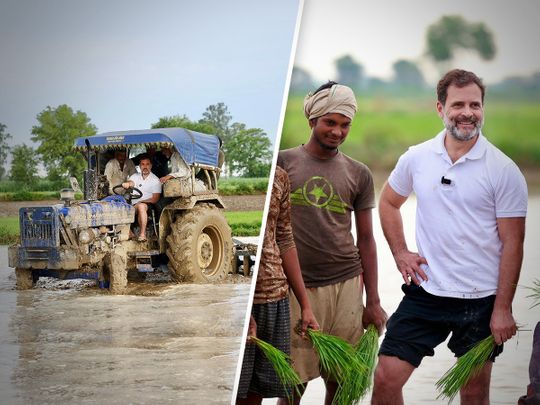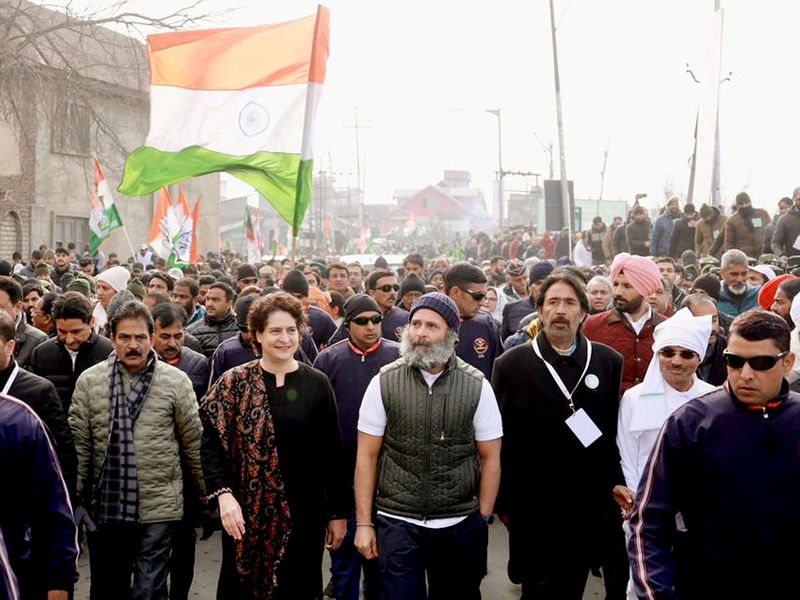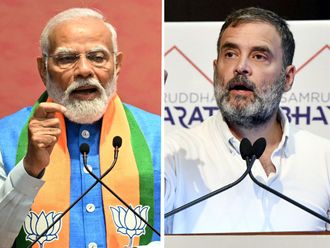
The most-watched video on Rahul Gandhi’s YouTube page has nearly 4 million views. It was posted just two months ago. It shows him talking to farmers in Haryana as they sow paddy. He rolls up his pants to get into the irrigated fields, and the conversation helps him understand the problems of the farmers. How do you do this? Show me. How much does this cost you? He then talks to the labourers and sows the paddy himself.
These photo-ops are not really new for Rahul Gandhi: one may recall him doing NREGA (National Rural Employment Guarantee Act — social welfare measure) work in a photo in the years when Congress was in power. But they have now become frequent and have acquired the power of video.
One day he’s a farmer, another day he’s a coolie. One day he’s sharing hostel food with students at Delhi University, and another day he’s taking a bus ride in Bengaluru. One day he’s servicing bikes with a mechanic in Delhi’s Karol Bagh, and another day he’s travelling with truck drivers. And then there’s all the cooking and eating.
The new Aam Aadmi
Condemned for long by his opponents as an ‘elite dynast’ who does not understand the streets of India, Rahul Gandhi’s video shoots are recasting him as the representative of Aam Aadmi, the common man.
Representing the common man has long been a slot in Indian politics. The slot was occupied for a while by Arvind Kejriwal, who is now battling charges of using public money to lavishly refurbish his official residence. He’s no longer seen driving a humble Wagon-R but a fancy MG Gloster.
If Rahul Gandhi has carried forward one element from the Bharat Jodo Yatra, it is the Aam Aadmi act. This image has helped opposition leaders of all kinds bring disruption: from Mahatma Gandhi to Mamata Banerjee, from Jayaprakash Narayan to VP Singh.
Cut the clutter
This format helps Rahul Gandhi for many reasons. He’s a poor orator — which is fine, Indian politics is full of poor orators. Nobody could ever understand what Mulayam Singh Yadav was speaking, and he became chief minister of Uttar Pradesh four times and even India’s defence minister once. If you can’t impress a crowd from a stage, maybe you can do it from YouTube.
Secondly, the mainstream media at its best has a pro-BJP bias, and hence it will never be kind to Rahul Gandhi until he shows them that he has the support of the masses. The best way to cover that journey today is through social media. Reaching the masses directly, bypassing the mainstream media — exactly what Narendra Modi started doing around 2011.

YouTube is easily the most influential social media platform in India today. It is seen at least once a month by 50 crore or 500 million Indians. India’s 2024 general election will be a YouTube election in the way that 2019 was a Whatsapp election and 2014 was a Facebook election.
Rahul Gandhi’s Aam Aadmi act helps him in another way. It contrasts him with his powerful opponent, Prime Minister Narendra Modi, who mesmerises millions through rally speeches broadcast on television. Contrast is a powerful force in politics: when people are bored of one kind of leader, they look for someone very different. Clones never win.
The missing message
And yet, there is something missing in this Aam Aadmi act. It is the element of a campaign. A campaign usually has a name, a slogan, and most importantly a specific demand. Mahatma Gandhi demanded the British leave India, LK Advani demanded a Ram Mandir, Jayaprakash Narayan demanded an end to Indira Gandhi’s authoritarianism, VP Singh demanded an investigation into corruption allegations over Bofors artillery guns, and Arvind Kejriwal demanded a Lokpal anti-corruption ombudsman law.
What is Rahul Gandhi demanding? What is he agitating about? What does he want? If you see the videos, read his tweets and hear his speeches, he’s demanding everything. That one singular demand, topic, and narrative is missing. This was also true of the Bharat Jodo Yatra.
Without a structured, coherent campaign narrative, Rahul Gandhi’s video ops come across as random. They would be much more powerful if they were attached to a theme — job creation, inflation, or perhaps something broader like a social security charter.
The absence of such a campaign element makes him come across as a leader without a vision. People vote for leaders who can show them the light at the end of the tunnel. People want to know how, if at all, Rahul Gandhi can take India and Indians on a better path than Modi. Until Rahul Gandhi can answer that question, no amount of Aam Aadmi videos will get him the swing vote.









